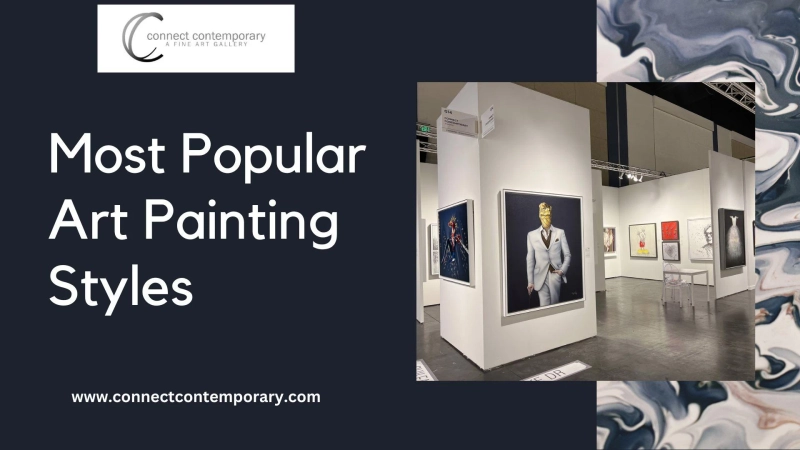The pleasure of painting in the 21stcentury is influenced by the range of readily available ways of expression. In the later parts of the 19th and early 20th centuries, painters achieved significant advancements in painting methods. Technological advancements, like the advent of photography and the metal paint tube, along with the changes in philosophical, political, and social conventions and external events all had an impact on many of these innovations.
There are different types of art painting styles one can find in various art galleries in Atlanta, GA. This kind of diversity is brought on the basis of colors, material, topics, and technology. So, for your reference, here are some of the most popular styles of art painting styles you should know.
Impressionism
Impressionism gained popularity in Europe in the 1880s when several artists tried to grab the light via gesture and illusion rather than through the minute details of realism. It is always clear what you are looking at because of the vivid color strokes in Monet's water lilies and Vincent Van Gogh's sunflowers, regardless of how far away you are.
Despite being realistic, the objects have a brightness that is exclusive to this design. It is remarkable to think that when Impressionist art initially went on display, the majority of critics attacked and rejected it. What was formerly seen as a crude and insufficient painting technique is today valued and admired.
Abstraction
As the early decades of the 20th century advanced in Europe and America, painting grew less realistic. According to the artist, abstraction is the act of painting a subject's inside rather than its outside. A painter might make a complex subject simpler by highlighting its standout hues, shapes, or patterns, as Pablo Picasso did with his well-known mural of three musicians. With their sharp angles and straight lines, the performers don't look the least bit real, but it's still easy to identify them.
Realism
This artistic movement, often known as naturalism, is regarded as "true art" and has dominated painting since the Renaissance. With no stylization or abstraction, this kind of painting aims to capture the topic as it appears in reality.
The sense of depth and space is carefully crafted by the artist by adjusting the composition, colors, tones, and lighting to make the subject look realistic. The Mona Lisa painting by Leonardo da Vinci is a great example of the genre.
Painterly
The focus, as the title refers to, is the act of painting: the character of the brushstrokes and the real colors. By not eliminating the texture or traces carved out by a brush or other instrument, such as a palette knife, artisans who work in this technique don't strive to hide the materials they used to prepare the picture. Henri Matisse's artwork is a wonderful example of this technique.
In the early part of the 19th century, when the Industrial Revolution spread across Europe, the Painterly style emerged. Painting became the primary emphasis for artists when the metal paint tube's development liberated them from the confines of the studio. Although subjects were represented accurately, artists didn't try to cover up their technical skills.
Expressionism
Related movements like Expressionism and Fauvism began to surface in galleries and studios at the turn of the 20th century. Strong, fanciful colors that are meant to express how the artist feels or sees life rather than how reality actually is helpful to distinguish both.
Both methods have several key differences. Edvard Munch, along with other Expressionists, sought to capture the weirdness and dread of everyday life via the use of hyper-stylized brushwork and terrifying themes, which he regularly employed to good success in a number of his works of art.
Abstract
Abstraction refers to painting a subject's staple rather than its external elements, as per the artist. Since Pablo Picasso did with his popular mural of three musicians, a painting expert may shorten the subject by highlighting its essential forms, colors, or patterns. The outcomes don't appear to be the least bit authentic with their clean lines and angles, yet it's evident who they are.
Surrealism
Early in the 20th century, this fashion thrived and had its beginnings in France. This painting technique creates an amazing impression by contrasting several abstract ideas. It is primarily distinguished by subjective pictures that are accurately painted, removed from their typical situations, and arranged inside a nebulous or paradoxical framework.
Surrealist artworks are frequently nonsensical. Or, you can communicate your creative ideas through images that draw attention to your unconscious thoughts rather than your reasoning.
The Conclusion
Looking to buy painting artwork for your home? Get to know all popular art painting styles including Palm Beach Modern + Contemporary Art. Connect Contemporary is the most sought-after destination for art lovers. It represents artists through its gallery partners with an aim to highlight thought-provoking artwork. Choose from Craig Alan Art, McKay Otto, Shadow Art, Pezhman art, and several other artists here.
Disclaimer- The information provided in this content is just for educational purposes and is written by a professional writer. Consult us to know more about Most Popular Art Painting Styles.
0


